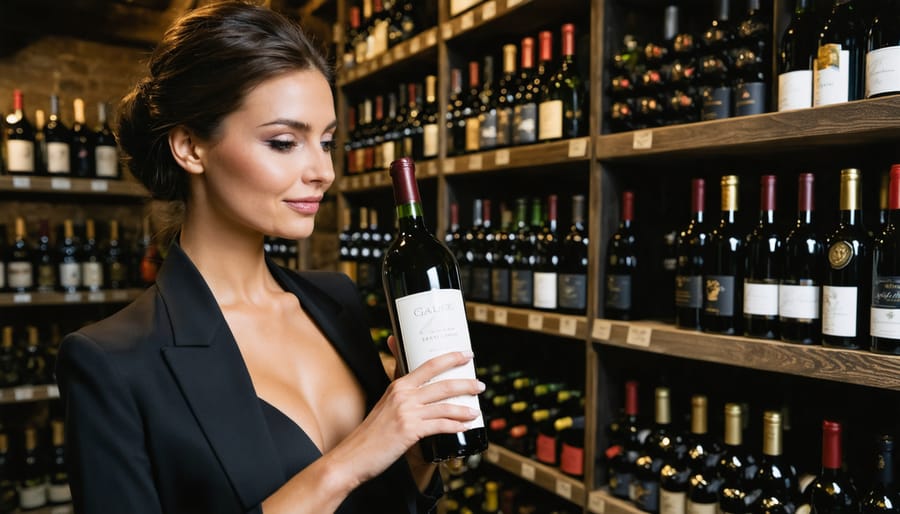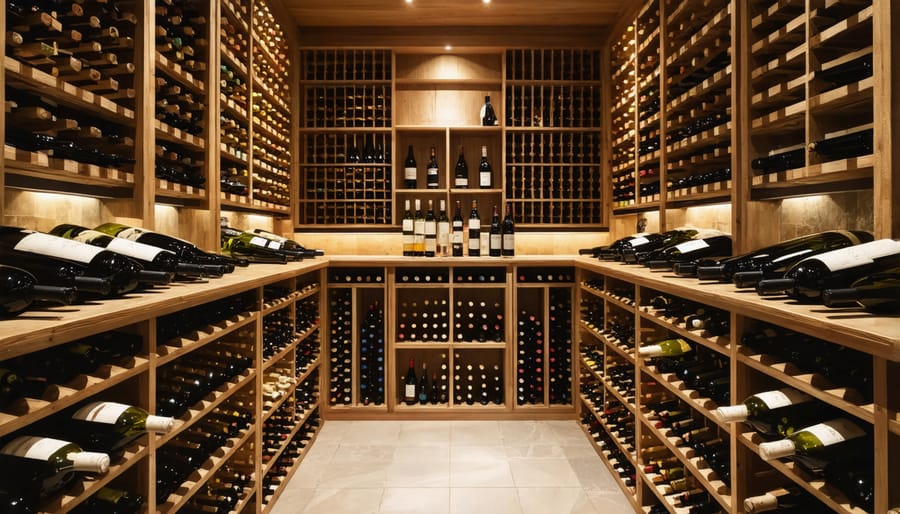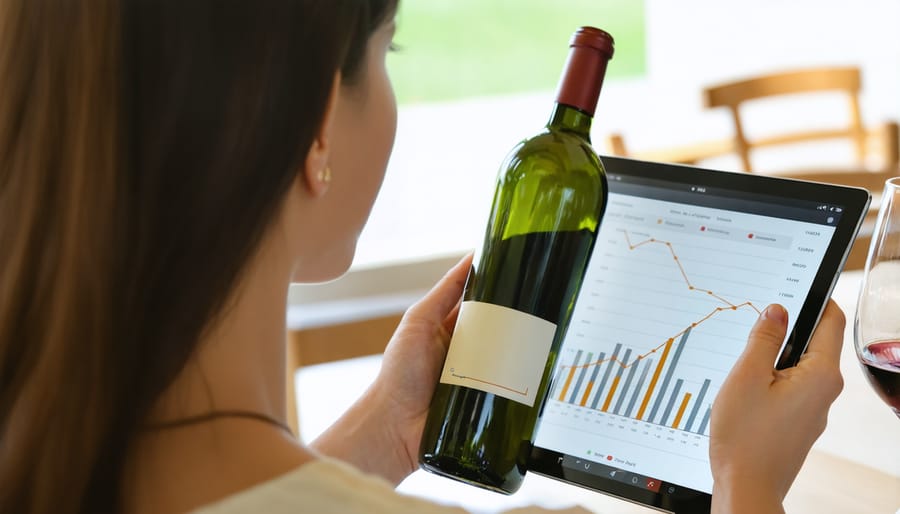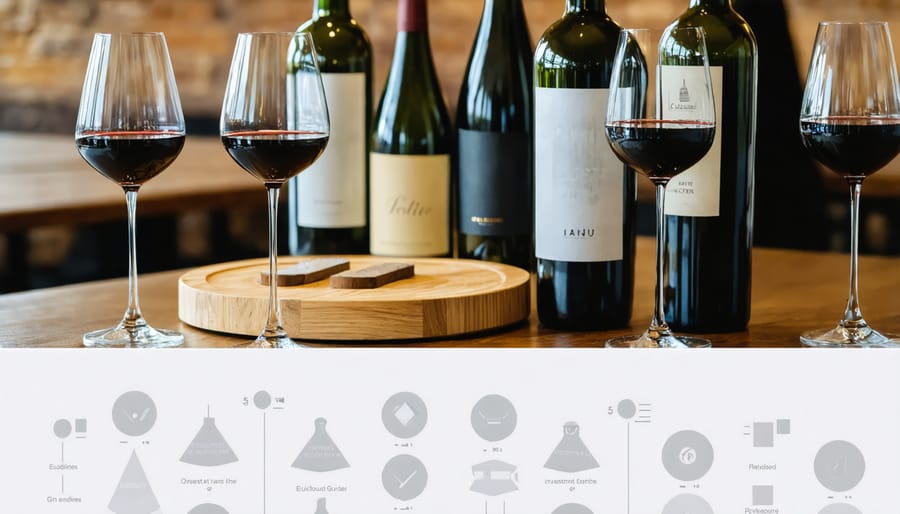
While fine wine once belonged exclusively to collectors and connoisseurs, savvy investors are now uncorking impressive returns in this sophisticated alternative investment market. Beyond the pleasure of owning prestigious bottles, wine investment has delivered average annual returns of 10-15% over the past decade, outperforming traditional assets like stocks and bonds. For women looking to diversify their portfolios with tangible assets, wine investing offers a unique blend of passion and profit potential.
Think beyond your evening glass of Cabernet – investing in fine wine means entering a $5 billion global market where top vintages from prestigious regions like Bordeaux and Burgundy can appreciate significantly in value. The beauty of wine investment lies in its relative stability during market volatility and its potential for substantial long-term growth, particularly as supplies of aged premium wines become increasingly scarce.
Whether you’re intrigued by the romance of owning cases of first-growth Bordeaux or attracted to wine’s track record as a wealth preservation tool, this guide will walk you through the essentials of building a profitable wine investment portfolio. From selecting investment-grade wines to proper storage solutions, we’ll uncork everything you need to know about joining the ranks of successful wine investors.
Why Fine Wine Makes a Smart Investment Choice

The Stability Factor
When I first dipped my toes into investment waters, I was amazed to discover how wine could act as a safety net in my portfolio. Unlike the roller-coaster ride of stock markets, wine investments tend to march to their own beat. Think of it as the calm friend in your investment circle – steady, reliable, and less likely to panic when markets get jittery.
What makes wine such a stable investment? For starters, fine wines become rarer and more valuable as time passes – it’s simple supply and demand. When collectors open and enjoy these bottles, fewer remain available, naturally driving up prices. Plus, sustainable wine investments are increasingly showing remarkable resilience, especially during economic uncertainties.
I’ve noticed that while traditional markets can swing wildly based on tweets or headlines, wine values typically remain unruffled. This stability comes from wine’s unique position as both an investment and a luxury commodity. Even during economic downturns, wealthy collectors continue to seek out rare vintages, helping maintain value when other investments might struggle.
Returns That Get Better With Age
Like a fine Bordeaux, wine investments tend to get better with time. While traditional investments might fluctuate wildly, fine wines typically show a steady appreciation pattern, with potential annual returns ranging from 8% to 12% over the long term. What makes wine particularly fascinating as an investment is that its value often increases as it becomes more scarce – after all, every time a bottle is consumed, the remaining bottles become more precious.
Think of it this way: when you purchase a case of investment-grade wine, you’re buying something that’s both finite and desirable. As wine matures and develops more complex flavors, its value typically rises. The most sought-after wines from prestigious regions like Burgundy and Bordeaux have shown remarkable price appreciation, with some vintages increasing in value by 150% or more over a decade.
However, patience is key – just as you wouldn’t rush a wine before its time, the best returns usually come from holding your wine investments for at least 5-10 years. This long-term approach allows the wine to reach its peak drinking window, when demand (and prices) tend to be highest.
Getting Started: Your Wine Investment Strategy

Building Your Wine Portfolio
Building a wine portfolio is like curating a beautiful collection of art – it requires passion, knowledge, and a dash of strategy. I remember starting my own collection with just two bottles of Bordeaux, and now I’m thrilled to share what I’ve learned along the way!
First, focus on diversification. Just as you wouldn’t put all your savings into a single stock, spread your wine investments across different regions, vintages, and price points. Consider including classic investment wines like Bordeaux First Growths and prestigious Burgundies, but don’t overlook up-and-coming regions like Tuscany and Napa Valley.
Start with established wines that have a proven track record of appreciation. Look for wines from exceptional vintages and renowned producers – these tend to be more stable investments. I suggest allocating about 60% of your portfolio to these “blue-chip” wines.
For the remaining 40%, explore emerging markets and younger vintages. These might offer higher growth potential, though they come with more risk. Spanish Riojas and Australian Shiraz have been gaining recognition in recent years.
Remember to consider storage conditions – proper temperature and humidity control are non-negotiable. Many collectors start with professional storage facilities until they can create ideal conditions at home.
Most importantly, invest in wines you actually enjoy. There’s something wonderful about having an investment you can taste and share with friends if the market doesn’t go your way!
Storage Solutions That Protect Your Investment
Just like a beautiful piece of art needs the right environment to maintain its value, your wine investment requires careful preservation. I learned this lesson firsthand when a friend’s valuable collection was compromised due to improper storage conditions. The good news? With the right setup, protecting your liquid assets is absolutely achievable.
Proper wine storage begins with controlling these essential factors: temperature, humidity, light, and vibration. The ideal temperature range is between 55-59°F (13-15°C), with humidity levels maintained at 70-75%. Consistency is key – fluctuations can be more damaging than slightly imperfect conditions.
Consider investing in a quality wine refrigerator for smaller collections or a dedicated cellar for larger portfolios. While the initial cost might seem significant, think of it as insurance for your investment. Professional storage facilities are another excellent option, offering climate-controlled environments and additional services like inventory management and insurance.
Remember to store bottles horizontally to keep corks moist and maintain proper seal integrity. Dark spaces are essential, as UV light can damage wine over time. And if possible, choose a location away from appliances that create vibrations, which can disturb the wine’s natural aging process.
For those just starting their collection, even a small dedicated space following these principles can make a significant difference in preserving your wine’s value and character over time.
Common Pitfalls to Avoid
As someone who’s helped many wine enthusiasts start their investment journey, I’ve noticed several common mistakes that can easily be avoided with the right guidance. Let me share these insights to help you navigate your wine investment path more smoothly.
One of the biggest pitfalls is letting emotions drive purchasing decisions. I remember being completely smitten by a beautiful bottle with an artistic label, only to later realize it had little investment potential. While it’s wonderful to love the wines you invest in, always prioritize market demand and investment potential over personal taste preferences.
Another common mistake is improper storage. Even the most valuable wines can become worthless if not stored correctly. Invest in proper temperature-controlled storage or professional wine storage facilities before building your collection. The small monthly cost is worth protecting your investment.
Many new investors also fall into the trap of not diversifying their portfolio. While it’s tempting to focus solely on prestigious Bordeaux wines, consider spreading your investments across different regions, vintages, and price points. This strategy helps minimize risk and maximize potential returns.
Insufficient research is another pitfall I frequently encounter. Don’t rely solely on scores from wine critics or buzz from social media. Take time to understand market trends, research historical price data, and connect with reputable wine merchants who can provide valuable insights.
Authentication is crucial – skipping proper verification can be costly. Always insist on proper documentation and provenance for your investments, especially for older or more expensive wines. Working with established dealers and auction houses can help ensure authenticity.
Lastly, avoid the misconception that wine investment is a get-rich-quick scheme. Like any investment, it requires patience, knowledge, and a long-term perspective. The most successful wine investors typically hold their collections for at least 5-10 years to see significant returns.
Making Wine Investment Work With Your Lifestyle
Balancing Collection and Consumption
Let me share a secret that many successful wine investors swear by: the 80/20 rule. Keep about 80% of your collection for investment purposes and 20% for personal enjoyment. This approach lets you experience the joy of wine while maintaining a solid investment portfolio.
Think of your wine collection as a carefully curated wardrobe – you have your investment pieces that appreciate over time, and your everyday favorites that bring immediate pleasure. The key is creating clear categories within your collection and maintaining detailed records of which bottles are for investing and which are for drinking.
When selecting wines for your “enjoyment collection,” consider purchasing multiple bottles of the same wine. This way, you can taste one bottle early to understand its development while keeping others for investment. It’s like having a preview of what your investment wines might taste like at maturity.
Storage is crucial for both categories. Whether you’re planning to drink or sell, proper temperature control and humidity levels are non-negotiable. Consider dedicating separate areas in your wine storage for investment pieces and drinking wines to avoid any mix-ups during celebratory moments!
Remember, even your investment wines shouldn’t be completely off-limits. Special occasions might warrant opening a prized bottle, and that’s perfectly okay. After all, the best wine collections tell stories of both prudent investment and memorable celebrations.
Building Your Wine Knowledge
Building your wine knowledge is an exciting journey that goes hand-in-hand with successful wine investing. I remember starting my wine journey feeling overwhelmed by terms like “terroir” and “tannins,” but taking small, consistent steps made all the difference.
Start by exploring certified wine education options, which can provide structured learning and valuable credentials. While formal education is beneficial, you can also develop your palate through regular tastings and self-study. Many wine enthusiasts begin with wine tasting fundamentals, learning to identify different varietals and regions.
Create a wine-tasting journal to document your experiences and observations. Note the wines you taste, their characteristics, and your personal impressions. Join local wine clubs or online communities where you can share experiences and learn from others. These groups often organize tastings and educational events, providing networking opportunities with fellow investors and enthusiasts.
Subscribe to respected wine publications and follow influential wine critics on social media. Their insights can help you spot emerging trends and understand market dynamics. Remember, developing your wine knowledge isn’t just about memorizing facts – it’s about cultivating a genuine appreciation for wine while building the expertise needed to make informed investment decisions.

Wine investment offers an exciting blend of passion and potential profit, making it an increasingly attractive option for those looking to diversify their investment portfolio. As we’ve explored throughout this article, the world of wine investing isn’t just for seasoned collectors or financial experts – it’s accessible to anyone with enthusiasm and the right knowledge.
Remember, successful wine investing starts with understanding your goals and comfort level. Whether you’re drawn to the romantic notion of owning prestigious vintages or seeking long-term financial returns, there’s a place for you in this fascinating market. Start small, focus on learning about regions and vintages that interest you, and gradually build your expertise alongside your collection.
I’ve seen many women in our community begin their wine investment journey with just a few carefully chosen bottles, eventually developing impressive portfolios that reflect both their personal taste and investment savvy. The key is to remain patient, stay informed about market trends, and maintain proper storage conditions for your investment.
As you begin this exciting journey, don’t forget to enjoy the process. Join local wine tasting groups, connect with fellow investors, and celebrate your successes along the way. While the potential financial returns are appealing, the knowledge, experiences, and connections you’ll gain are equally valuable.
Ready to take your first step into wine investing? Start by researching reputable wine merchants, setting a realistic budget, and perhaps treating yourself to that first investment-worthy bottle. Your future self will thank you for making this sophisticated and potentially rewarding choice today.



